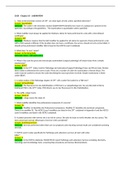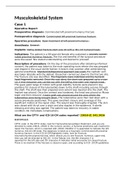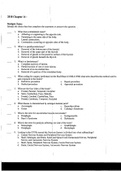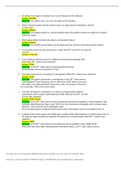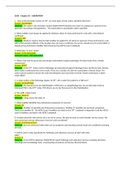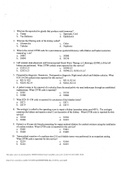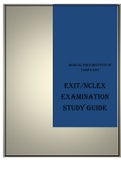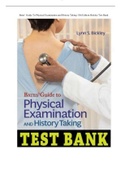University Of San Francisco
Latest uploads at University Of San Francisco. Looking for notes at University Of San Francisco? We have lots of notes, study guides and study notes available for your school.
-
253
- 0
-
15
All courses for University Of San Francisco
Latest notes & summaries University Of San Francisco
Chapter 18 – LABORATORY 1. Tests in the Chemistry section of CPT® are what types of tests unless specified otherwise? Answer: Quantitative Rationale: The codes in the Chemistry section (82009-84999) identify how much of a substance is present in the specimen. According to the guidelines, “The examination is quantitative unless specified.” 2. What modifier must always be applied to Medicare claims for tests performed in a site with a CLIA Waived certificate? Answers: QW Rationale: ...
Musculoskeletal System Case 1 Operative Report Preoperative diagnosis: Comminuted left proximal humerus fracture Postoperative diagnosis: Comminuted left proximal humerus fracture Operative procedure: Open treatment of left proximal humerus. Anesthesia: General. Implants: DePuy Global fracture stem size 10 with a 48 x 15 humeral head. Indications: The patient is a 66-year-old female who sustained a severely comminuted proximal humerus fracture. The risk and benefits of the surgical proce...
1. What does contralateral mean? a. Affecting or originating in the opposite side. b. Pertaining to the same side of the body. c. Lateral contractions. d. Contractions occurring on opposite sides of the body. i 2. What is a parathyroidectomy? a. Removal of the bottom part of the thyroid. b. Removal of the upper part of the thyroid. c. Removal of glands on the posterior surface of the thyroid. d. Removal of glands beneath the thyroid. I 3. What is a laminotomy? a. Complete excision of...
Chapter 15 - EYES - to complete
1. An axillary view might be included in an x-ray of what part of the skeleton? Answer: Shoulder Rationale: The axillary view is an x-ray view taken of the shoulder. 2. Which anatomic position has the patient lying at an angle instead of lying flat or directly on their side? Answer: Oblique Rationale: The oblique position is a slanted position where the patient is lying at an angle that is neither prone nor supine 3. Which plane divides the body into anterior and posterior halves? Answe...
Chapter 18 – LABORATORY 1. Tests in the Chemistry section of CPT® are what types of tests unless specified otherwise? Answer: Quantitative Rationale: The codes in the Chemistry section (82009-84999) identify how much of a substance is present in the specimen. According to the guidelines, “The examination is quantitative unless specified.” 2. What modifier must always be applied to Medicare claims for tests performed in a site with a CLIA Waived certificate? Answers: QW Rationale: ...
1. What are the reproductive glands that produce male hormones? a. Testes c. Spermatic Cord b. Vas Deferens d. Epididymis 2. What are the filtering units of the kidney called? a. Glomerulus c. Calyx b. Tubules d. Nephrons 3. What is the correct CPT® code for a percutaneous pyelostolithotomy with dilation and basket extraction measuring 1 cm? a. 50081 c. 50080 b. 50040 d. 50130 4. Left ureteral stent placement and Extracorporeal Shock Wave Therapy or Lithotripsy (ESWL) of the left kid...
DIAGNOSIS PLANNING IMPLEMENTATION Nursing process- REMEMBER ASSESS FIRST BEFORE IMPLEMENTATION – ASK YOURSELF IS THERE ENOUGH INFORMATION GIVEN TO TAKE ACTION. YOU CANNOT IMPLEMENT UNLESS YOU HAVE ENOUGH INFORMATION EXAMPLE The night after an exploratory laparotomy, a patient who has a nasogastric tube attached to low suction reports nausea. A nurse should take which of the following action first? a. Administer the prescribed antiemetic to patient b. Determine the patency of the pati...
Bates’ Guide To Physical Examination and History Taking 13th Edition Bickley Test Bank CHAPTER 1 Foundations for Clinical Proficiency MULTIPLE CHOICE 1. After completing an initial assessment of a patient, the nurse has charted that his respirations are eupneic and his pulse is 58 beats per minute. These types of data would be: a . Objective. b . Reflective. c . Subjective. d . Introspective. ANS: A Objective data are what the health professional observes by inspecting, percus...
Includes notes from class discussions and readings such as Burke, Aristotle, Jhally, Schor, etc. Also includes notes that’ll help pass the exams

